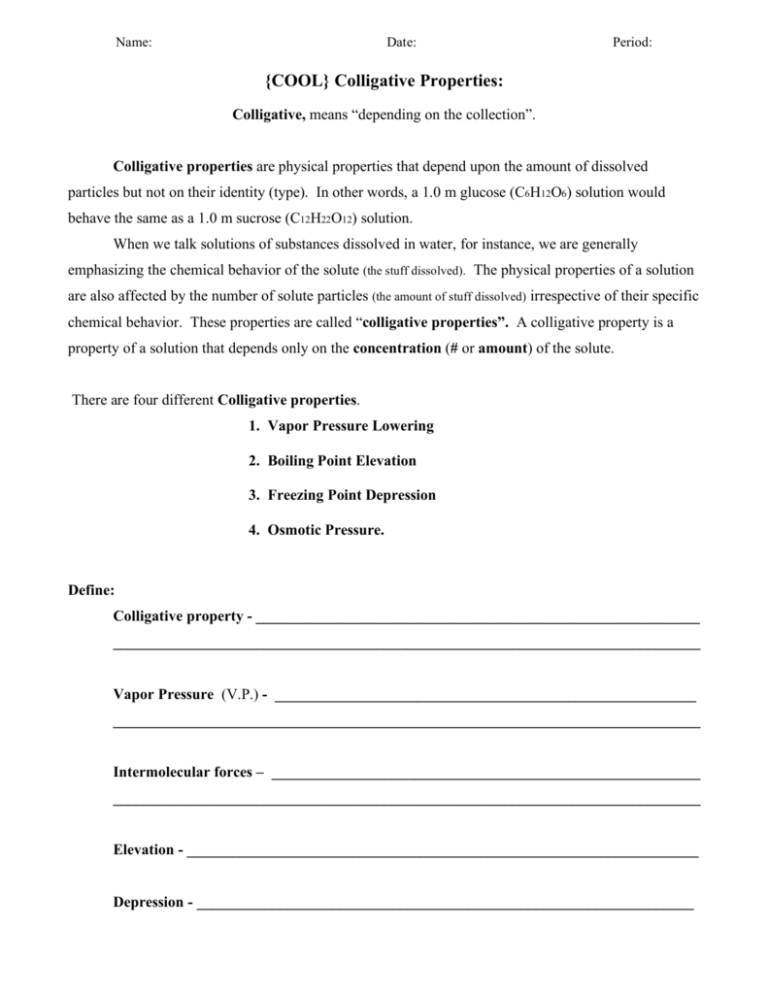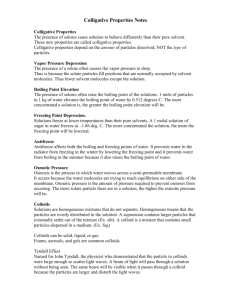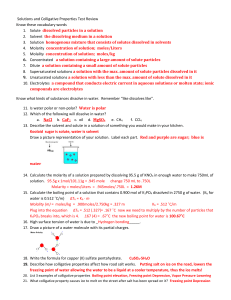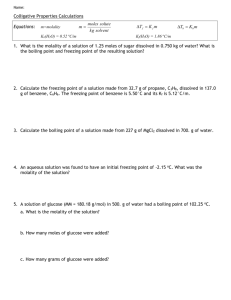Colligative properties L1
advertisement

Name:
Date:
Period:
{COOL} Colligative Properties:
Colligative, means “depending on the collection”.
Colligative properties are physical properties that depend upon the amount of dissolved
particles but not on their identity (type). In other words, a 1.0 m glucose (C6H12O6) solution would
behave the same as a 1.0 m sucrose (C12H22O12) solution.
When we talk solutions of substances dissolved in water, for instance, we are generally
emphasizing the chemical behavior of the solute (the stuff dissolved). The physical properties of a solution
are also affected by the number of solute particles (the amount of stuff dissolved) irrespective of their specific
chemical behavior. These properties are called “colligative properties”. A colligative property is a
property of a solution that depends only on the concentration (# or amount) of the solute.
There are four different Colligative properties.
1. Vapor Pressure Lowering
2. Boiling Point Elevation
3. Freezing Point Depression
4. Osmotic Pressure.
Define:
Colligative property - ___________________________________________________________
______________________________________________________________________________
Vapor Pressure (V.P.) - ________________________________________________________
______________________________________________________________________________
Intermolecular forces – _________________________________________________________
______________________________________________________________________________
Elevation - ____________________________________________________________________
Depression - __________________________________________________________________
Vapor Pressure is the pressure (force of collision) caused by liquid (phase) molecules evaporating (breaking
intermolecular forces)
becoming gas molecules (Higher Kinetic Energy) and colliding with the atmosphere gas above.
Evaporation, What is it? & Where does it occur?
Recall that evaporation takes place at the surface of a liquid. When a particle has sufficient
kinetic energy to escape from the intermolecular forces. Dissolved substances that are present will be
evenly distributed throughout the solution and will take up a portion of the surface particles. Therefore,
the solvent in a solution will have fewer opportunities to evaporate because the solute particles will get
in the way. The end result is that solutions will evaporate slower than pure solvents and solutions will
have a lower vapor pressure (pure solvents have higher V.P.). This effect does not depend on the identity (or
type) of substance dissolved (the solute). It only depends upon the concentration.
-
The rate of evaporation for a solution (dissolved mixture) will be Lower than it is for the pure solvent alone.
(Pure Water will have a higher rate of evaporation (higher V.P.) than Salt Water, at the same temperature.)
Rev ie w:
- W he n ev apo rat io n r ate i s hig h, there i s mo re g as rel ea se d. T hus, at hig her eva pora ti on ra te s t he vap or pr essure is hi gher.
Boiling Point Elevation:
The Boiling point (B.P.) of a solution-mixture is always higher (more elevated) than a pure
substance (the solvent) alone. Because, by dissolving a solute in the solvent the dissolved particles get
in the way of evaporation making it harder, taking more energy, & higher temperatures to boil
(evaporate) the
liquid. The phenomenon, called “Boiling Point Elevation”, is the temperature
difference between a solution’s boiling point and a pure solvent’s boiling point.
For example we all know that pure water boils at 212 degrees Fahrenheit (°F) or 100 degrees
Centigrade (or Celsius, °C). We might also know that we can raise the cooking temperature of
spaghetti noodles by adding table salt to the pot. Why? Well, making salty spaghetti is not the
objective (but does happen). The salt raises the boiling point of the water and the spaghetti cooks
faster at the higher temperature. We call this increase in the boiling point, “boiling point elevation”.
What is unique, and makes this physical change a colligative-physical property, is that it almost
doesn’t matter what substance you use; table salt, road salt, sugar or anti-freeze, the boiling point of
the water will increase by the same amount based on the number of particles of solute that is in the
solution.
(Salt Water will have a higher Boiling point, than Pure Water)
Freezing Point Depression:
The Freezing point (F.P.) of a solution-mixture is always lower (more depressed) than a pure
substance (the solvent) alone. Because, by dissolving a solute in the solvent the dissolved particles
do not get incorporated into the ice crystal and must be pushed aside first. This takes longer and
allows the freezing point to lower. Again it does not matter what particles are in the solution; salt,
sugar, anti-freeze, or even baking soda, it only matters HOW MANY particles are dissolved in the
solution…. This is a “Colligative Property”.
Revi ew:
- The overall effect of adding a solute ( dissolved pa rt icl es ) is that the range where a solu tion remain s a liquid is
greater than it is for the pure solvent.
{The more particles dissolved in solution will cause a greater decrease (depression) in the freezing point.}
{The more particles dissolved in solution will cause a greater increase (elevation) in the boiling point.}
In the Northeast where it gets really cold in the winter, we add antifreeze (ethylene glycol or
propylene glycol) to our automobile coolant to prevent it from freezing. Just as a solute can raise the
boiling point, it also lowers the freezing point of water. This phenomenon is called “freezing point
depression”. Antifreeze prevents freezing by lowering the freezing point of the water solution to a
temperature below what we might expect to actually occur on the coldest day in winter.
-
Ethylene glycol or propylene glycol, are called “Coolants” when they act as boiling point elevators.
-
Ethylene glycol or propylene glycol, are called “A ntifree ze ” when they act to depress(lower) the freezing point of water in our automobile radiators.
Osmotic Pressure (O.P.)
Osmotic pressure is the minimum pressure that is required to stop the net flow of osmosis.
Osmosis is the flow of a solvent through a semi-permeable membrane to dilute a more concentrated
solution. The word “permeable” means allowing substances to pass through it. Semi-permeable means
that some substances can pass through and others cannot (like, selectively-permeable). When dealing
with osmosis, the solvent is water and it can pass through the membrane/barrier but the solute cannot.
Osmotic pressure is the force of the water molecules pushing back on the solute particles and on
the other water molecules that are incoming).
Review:
O.P. is caused by the water molecules that move into the solution and create additional pressure.
Boiling Point Elevation & Freezing Point Depression:
- Equations and problem solving:
Equation Variables:
Δ , means “change in” (increase in boiling point or decrease in freezing point)
T , means “temperature” (Not the actual or final temperature, only the change in temp. that occurs.)
- boiling point elevation – Add
Δ Tb to actual boiling point to get final answer.
- freezing point depression – Subtract
Δ Tf from actual freezing point.
K , means “Constant” (refer to table next to equations)
m , means “Molality” (moles of solute per kilogram of solvent)
Rememb er:
1. Colligative properties chang e when the amount of solute ch anges!
2. B.P. Elevation & F.P. Depression are Colligat ive properties, & both change when the amount of
dissolved partic les (the so lute) changes!
What happens to the amount of particles in a solution when an electrolyte (or ionic compound) dissolves in water?
- All ionic compounds are elect rolyt es and they ALL dissociat e (or breaks ap art) int o ions…
A certain mass of table salt (NaCl) will raise the boiling point of water twice as high as the same amount of a sugar like glucose (or
sucrose) because the NaCl will ionize into two particles for each “molecule” of salt added where as the glucose just dissolves as one
species (or one particle). By the same idea a more complex salt like calcium chloride (CaCl2) will increase the boiling point three
times that of an identical amount of glucose because three ions are formed when CaCl2 dissolves (dissociates in water).







